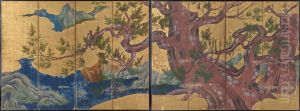Kano Eitoku Paintings
Kano Eitoku was a prominent Japanese painter who played a significant role in the development of the Kano school of painting during the Azuchi-Momoyama period of Japanese history. Born in Kyoto in 1543, Eitoku was part of the esteemed Kano family, which had been influential in the world of Japanese art for many generations. His grandfather, Kano Motonobu, was an important figure who had established the Kano school's reputation, and Eitoku was set to continue that legacy.
Eitoku's early years were spent training under the guidance of his father, Kano Shoei, as well as his grandfather, Motonobu. His natural talent and lineage allowed him to master the techniques and styles that were characteristic of the Kano school. This school was known for its blend of Chinese-inspired ink painting with native Japanese decorative approaches, creating works that were both bold and elegant.
As he matured as an artist, Eitoku became known for his large-scale screen paintings and fusuma (sliding door) panels that adorned the castles and residences of powerful feudal lords, such as Oda Nobunaga and Toyotomi Hideyoshi. His work was characterized by dynamic compositions, robust figures, and a dramatic use of color and gold leaf. One of his most famous works is the screen painting 'Cypress Trees,' which exemplifies his vigorous brushwork and imposing forms.
Eitoku's success was not only due to his artistic skills but also his ability to navigate the political landscape of his time, securing commissions from the most influential figures of the day. His art was a reflection of the power and ambition of these warlords and helped to define the visual culture of the period.
Tragically, Eitoku's life was cut short when he passed away in 1590, at the age of 47. Despite his relatively short life, his impact on the world of Japanese art was profound. He had several students and followers who continued his legacy and the Kano school's dominance in Japanese painting for centuries to come. Eitoku's work represents a pinnacle of Japanese screen painting and continues to be celebrated for its vigor, grandeur, and historical significance.



